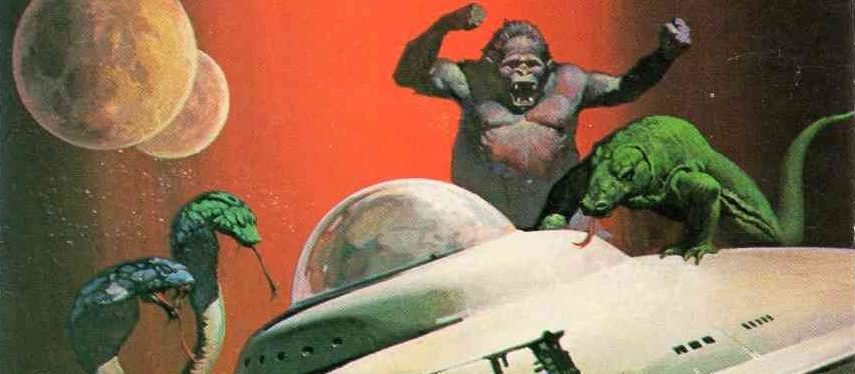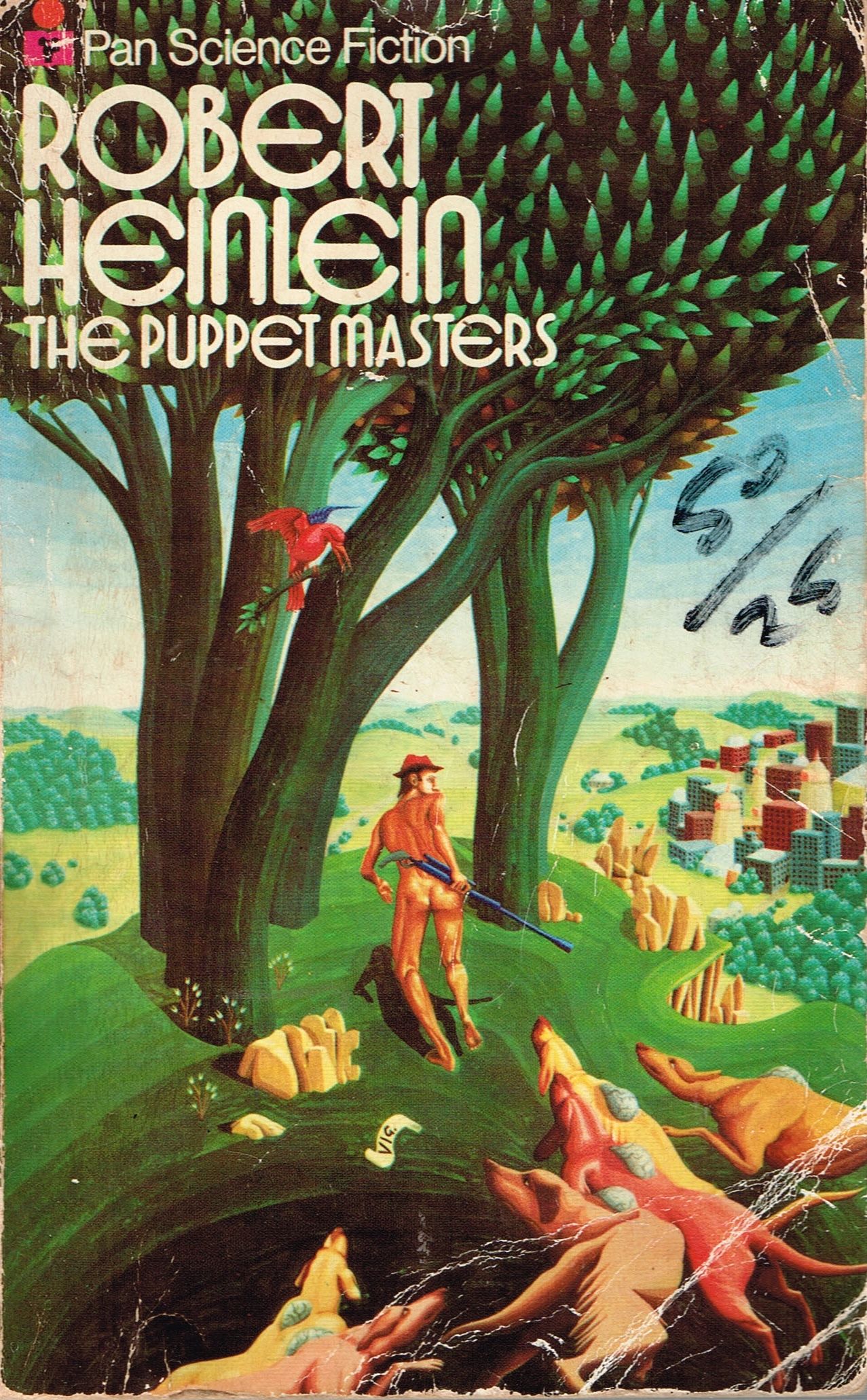

“The problem with dictatorships—as I read somewhere recently—and with poisonous ideologies, too, is that they are like sharks. They must keep moving forward or die. What caused their aggression is not what you did. It’s who they are.”
Robert A Heinlein’s The Puppet Masters is a fun sci-fi romp in which a parasitic, mind-controlling alien species from Titan attempts to take over the earth. Sometimes serious, but often silly, it does a decent job of keeping things loose without getting too soft. The outlandish alternate-future world that Heinlein envisions—UFOs, telephones embedded in skulls, self-flying cars, etc.—never overwhelms a solid sense of logic and attention to detail that allow the book to flow nicely, especially in its first half. In some ways it feels dated—namely in its hot-blooded male perspective and its overt comparisons between the parasitic slugs and communism. But the prose is very relaxed and unpretentious, and it moves along in a rambunctious, carefree way that doesn’t feel archaic at all. Maybe it is naive and unsophisticated, but it is certainly readable.
The slug-like creatures arrive on the scene via flying saucer just before the book begins. Our trio of main characters—all agents of a secret government organization—work up a cover as a tourist family in order to get a close look at the ship. Sam, who tells the story in the first person, is immensely attracted to his fellow agent Mary, barely kept in line for the moment because they are posing as siblings. Their boss, the Old Man, poses as an uncle. They get a good look at the ship—an obvious fake—which is announced shortly as a giant hoax, a schoolboy prank. But two agents had already gone to investigate and not reported back; and none of the local men are attracted to Mary, so we know something is off.
The slugs begin discreetly mounting themselves on the spines of humans, rounding the shoulders of their hosts and controlling their thoughts and actions from under the cover of their clothing. The controlled humans can passably keep up a charade of human-like activity indefinitely, though they do not clean themselves. Our narrator himself is soon mounted by a slug and comes under the hivemind control of them. Throughout the ordeal he remains aware of his predicament, but because his mind has been altered by the parasites, he is curiously invested in aiding them.
Predictably, the government is hesitant to take action based on the eye witness testimony of only a few people. The Old Man, a reluctant leader who seems to do the job because no one else will, struggles to get things done—that is until the situation spirals wildly out of control. But by the time the President acts, large swaths of the country are already totally under the control of the things. Those remaining under their own control implement various and increasingly undignified measures, which makes every non-hagridden citizen look like they are badly losing a game of strip poker.1
The plot gets very silly at times—three-quarters naked people, wisecracking secret agents, an impulsive marriage, hagridden gorillas and cats. The futuristic ideas that Heinlein includes, from flying saucers2 to five-minute facial alterations, were original at the time. Sci-fi was still figuring itself out as a genre as it transitioned from the pages of pulp magazines to the novel format (The Puppet Masters was originally serialized across three issues of Galaxy Science Fiction). Heinlein’s B-movie plot isn’t very sophisticated, but his writing style keeps it interesting. He doesn’t just set up the premise then hope we remain interested as he trudges toward a conclusion. He offers a steady trickle of new details that flesh out the world and fills his main character’s head with a slew of witty thoughts. The plot kind of loses steam in its final third, where Mary—who, it turns out, is from Venus—is psychoanalyzed in order to figure out how she survived being hagridden as a little girl.
So many years after its publication, the dynamic between Sam and Mary (or just Sam and women in general) is fairly off-color. But I don’t read books from the 1950s and expect to find 21st century sensibilities.3 I’m willing to accept the book as it was written in its time. My issue with this dynamic is not with Heinlein’s worldview, but with his writing of the character of Mary. She is introduced to us as a whip smart, deadly secret agent, on par with her male colleagues, but then she turns out to be a boring, subservient non-character whose only utility is tied up in her past as a survivor of being hagridden. She is such a prominent part of the book, though, that it makes for some annoying portions where you are hoping she will either become the competent agent we have heard about or get mounted by a slug and become a villain.
Most minds stall dead when faced with facts which conflict with basic beliefs; ‘I-just-can’t-believe-it is all one word to highbrows and dimwits alike.
Interestingly, the book had a third of its length removed for its initial publication, a number of risqué elements culled in order to make the book more palatable to the general public. In the uncut version (which I have not read), the book begins with Sam waking up next to a woman he had bedded without even bothering to learn her name. In both versions, a lack of sex drive in those who have been hagridden is a clue for the protagonists. In the uncut version, though, the slugs eventually discover human sexuality and begin broadcasting orgies on television.
The book came out several years before the similarly-themed The Body Snatchers by Jack Finney. Both were written in the midst of the Red Scare, when Americans were afraid the communists were transforming the nation from the inside out. Finney’s novel was adapted to the screen almost immediately as Invasion of the Body Snatchers, then remade a few decades later with a bigger budget.4 Heinlein’s novel served as an inspiration for episodes of Star Trek and The Outer Limits but wasn’t officially adapted to the big screen until the mid-90s.
The Puppet Masters, while certainly of its time, is still an enjoyable book to read. Heinlein’s pulpy writing style is very fresh and witty, intelligent yet refraining from self-seriousness. It’s final third doesn’t capitalize on the promise of its paranoid buildup, but it’s good enough to get you to the crusading voyage to Titan that marks its end. I had fun with it but it’s not something I couldn’t have lived without.
1. “Hagridden” is the phrase Heinlein uses for those under the control of the slugs.
2. Flying saucer “sightings” were very common in the 1950s but the trope wasn’t really ingrained into popular culture yet.
3. This is a big pet peeve of mine—people essentially hate-reading books and then trashing the author. I am convinced those people are morally chameleonic and would have been Nazis had they been born in the right circumstances.
4. It’s received two more adaptations since then.